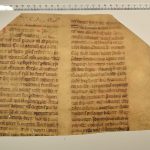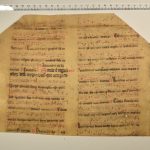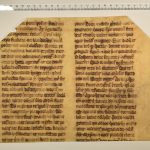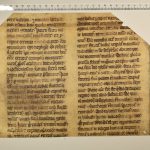The general description of the fragment group see at F 328a (Fr. l. m. 265)
On these fragments the original width of the codex can be measured, since the book binder cut only horizontally on the folios. The measured data, alas, are not precise, hence after the fragments in the 20th century have been drawn off the host book and cleaned, they were put in a press, and this deformed them to a degree. The curvedness of the lines of text and notes, a result of this process, is especially conspicuous in the case of fol. 1. Regardless, both fragments are valuable witnesses of the Sanctorale part of the Breviarium notatum Strigoniense.
Fol. 1 preserved a rich musical material from the Office of St. Cecilia. On the recto the second responsory of the Matin’s second Nocturne can be seen. The fragmental notation is from a master, contemporary to the main notator of the BNS, and working in the same manner as he had. On the verso the work of a third notator is visible. This latter scribe also used Esztergom notation, but didn’t draw the neumes with one motion, instead constructed them from elements („comminutive technique”). (In the first volume of the BNS the same scribe wrote the chants of Trinity Sunday and Corpus Christi, see ff. 208r-223v). The psalm antiphons and the first two responsories of the Cecilia-Matin’s third Nocturne appear in the first column, while the psalm antiphons and the (partially fragmental) Benedictus antiphon in the second.
The entire material of fol. 2 is a lesson, from the Passio of Catharine of Alexandria (see Bibliotheca Hagiographica Latina Antiquae et Mediae Aetatis (Bruxelles: Société des Bollandistes, 1898–1899). Vol/I. Nr 1663).
Gábriel Szoliva





